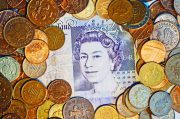 1638-39 Shilling – Charles I
-
Silver shilling of King Charles I, minted around 1638-1639 at the Tower (London) Mint. Second milled issue of Nicholas Briot.
1638-39 Shilling – Charles I
-
Silver shilling of King Charles I, minted around 1638-1639 at the Tower (London) Mint. Second milled issue of Nicholas Briot.
Shilling
 1638-39 Shilling – Charles I
-
Silver shilling of King Charles I, minted around 1638-1639 at the Tower (London) Mint. Second milled issue of Nicholas Briot.
1638-39 Shilling – Charles I
-
Silver shilling of King Charles I, minted around 1638-1639 at the Tower (London) Mint. Second milled issue of Nicholas Briot.
 1643 Shilling – Charles I York Mint
-
The 1643 Silver Shilling of King Charles I, York Mint. The Reverse shows a coat-of-arms over long cross fourchée with "EB OR" above (EBOR is an early name for York).
1643 Shilling – Charles I York Mint
-
The 1643 Silver Shilling of King Charles I, York Mint. The Reverse shows a coat-of-arms over long cross fourchée with "EB OR" above (EBOR is an early name for York).
 1623 Shilling – James I
-
The 1623 Shilling of King James I was struck between 1623 and 1624. Third coinage. Tower (London) mint. XII indicates 12 pence (one shilling).
1623 Shilling – James I
-
The 1623 Shilling of King James I was struck between 1623 and 1624. Third coinage. Tower (London) mint. XII indicates 12 pence (one shilling).
 1758 Shilling – George II
-
1758 Shilling of King George II is probably the most common (and least expensive) of the George II shillings.
1758 Shilling – George II
-
1758 Shilling of King George II is probably the most common (and least expensive) of the George II shillings.
 1745 Shilling – George II LIMA
-
Below the bust is 'LIMA'. This indicates the metal came from captured Spanish ships off the coast of the Peruvian city of Lima.
1745 Shilling – George II LIMA
-
Below the bust is 'LIMA'. This indicates the metal came from captured Spanish ships off the coast of the Peruvian city of Lima.
 1551 Shilling – Edward VI
-
Struck at the Tower Mint, London. Third period. 'XII' on right is the mark of value, representing 12 pence (= one shilling).
1551 Shilling – Edward VI
-
Struck at the Tower Mint, London. Third period. 'XII' on right is the mark of value, representing 12 pence (= one shilling).
 1921 Shilling – George V
-
The Reverse shows a crowned lion passant on top of a crown, by George William de Saulles.
1921 Shilling – George V
-
The Reverse shows a crowned lion passant on top of a crown, by George William de Saulles.
 Introduction to British Coins – Current and Pre-Decimal
-
British coinage has a long history. The article describes the current coinage and the coins of the century or so before that.
Introduction to British Coins – Current and Pre-Decimal
-
British coinage has a long history. The article describes the current coinage and the coins of the century or so before that.
 1685 Shilling – James II
-
King James II Shilling minted by the Royal Mint at the Tower Mint in London. Design is SCBC 3410 and was used 1685-1688, with a few variants.
1685 Shilling – James II
-
King James II Shilling minted by the Royal Mint at the Tower Mint in London. Design is SCBC 3410 and was used 1685-1688, with a few variants.
 1892 Shilling – Victoria
-
The Reverse shows a crowned Royal shield surrounded by a garter holding the motto 'HONI SOIT QUI MAL Y PENSE' (Evil be to him that evil thinks).
1892 Shilling – Victoria
-
The Reverse shows a crowned Royal shield surrounded by a garter holding the motto 'HONI SOIT QUI MAL Y PENSE' (Evil be to him that evil thinks).
